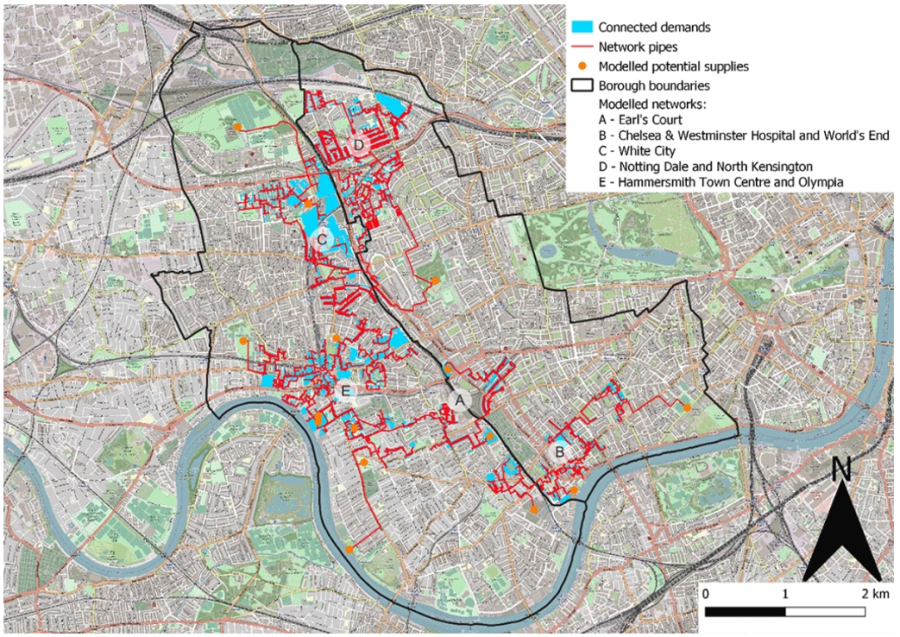Policy CR3
Heat network connections
a) All major developments proposed within the borough's Heat Network Priority Area(s) are required to either connect to an existing heat network or include their own communal heat network system which can be connected to a wider network in the future.
b) Where connection to a heat network is proposed, priority should be given to those networks with the lowest carbon emissions. If connection to a gas-powered network is proposed (e.g. an existing CHP based system), this will need to include details on the decarbonisation plan for that network.
c) Where schemes propose their own heat networks, these will need to be designed and installed to enable future connection to other networks. This includes provision of plant and equipment capable of future connection or sufficient space to install required infrastructure and identifying/safeguarding any routes required for network connection pipe runs.
5.19 As identified in the council's Cross Borough Energy Masterplan, "Heat networks, also known as district heating, supply heat from one or more central sources to consumers through a network of underground pipes carrying hot (or, in some cases, ambient temperature) water, which deliver space heating and hot water to individual buildings. This avoids the need for individual heating systems installed in every building".
5.20 Heat networks are considered to be one of the most cost-effective ways of providing heat, reducing carbon emissions and meeting the council's 2030 net zero carbon targets.
5.21 The modelling undertaken in the development of the Energy Masterplan showed high viability of heat networks across the entire study area, as illustrated below with scope to connect to wider networks in RBKC. Hammersmith & Fulham is also in one of the GLA's Heat Network Priority Areas which identifies it as a borough where major developments should have communal low temperature heating systems.
5.22 The central heat source can be one of many technologies. Common low carbon examples are very large heat pumps including air source and ground source heat pumps and waste heat from secondary sources such as data Centres.
5.23 Heat networks should be designed and installed in a way that enables future connections to be made by neighbouring sites as part of any expansion of district wide heat networks that may come forward in the future. If a heat network is not included in a scheme for some reason, it must still be designed to be future-proofed and capable of future connection.
5.24 If an existing gas-powered network is proposed to be connected to, then evidence will also need to be provided on the proposed decarbonisation of that network to show that it will achieve net zero carbon targets.
5.25 It is recommended that developers follow the guidance set out in the GLA's London Heat Network Manual II[1] which provides practical technical and commercial guidance for developers on heat network design, installation and use.
5.26 The Government is expected to accelerate the development of heat networks in the near future through implementing the Heat Network Zoning powers in the Energy Act 2023 which will mean that certain types of development and buildings will be required to connect to such networks where they are available.
5.27 Where new developments are built in an area where they cannot connect to an existing network, but where a heat network could become available in the future, they should demonstrate that their energy strategy will enable the scheme to be "heat network ready". This means that the design of any communal heating system that is proposed for a scheme should enable it to connect to a heat network in the future.
5.28 To facilitate this, buildings containing multiple units should use communal heating systems instead of individual heating systems and space should be included in building designs to accommodate heat network pipes and other connection plant and equipment.
Heat pumps
5.29 For heat pump based communal heating systems, if it is proposed to include additional technologies, such as gas and/or electric boilers to top up heat to serve demand peaks then this needs to be explained and included in assessment of carbon emissions for the development. Use of electric rather than gas boilers is strongly encouraged where appropriate grid capacity is in place. Use of gas or mains electricity for peak loads must be minimised by including good energy centre sizing to provide all baseload heating (and cooling if used), use of thermal storage, and demand response measures.
Potential Heat Networks in Hammersmith and Fulham
